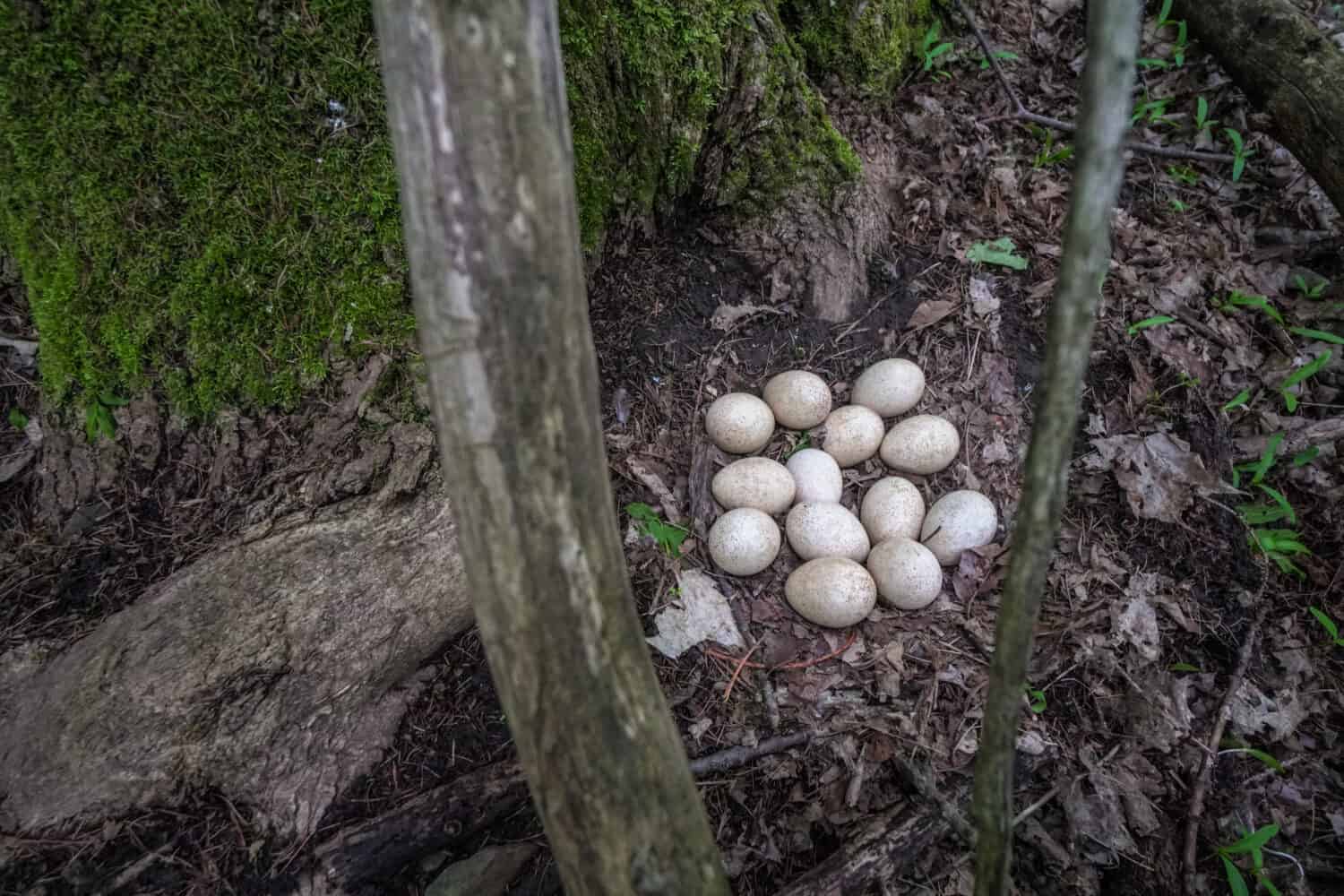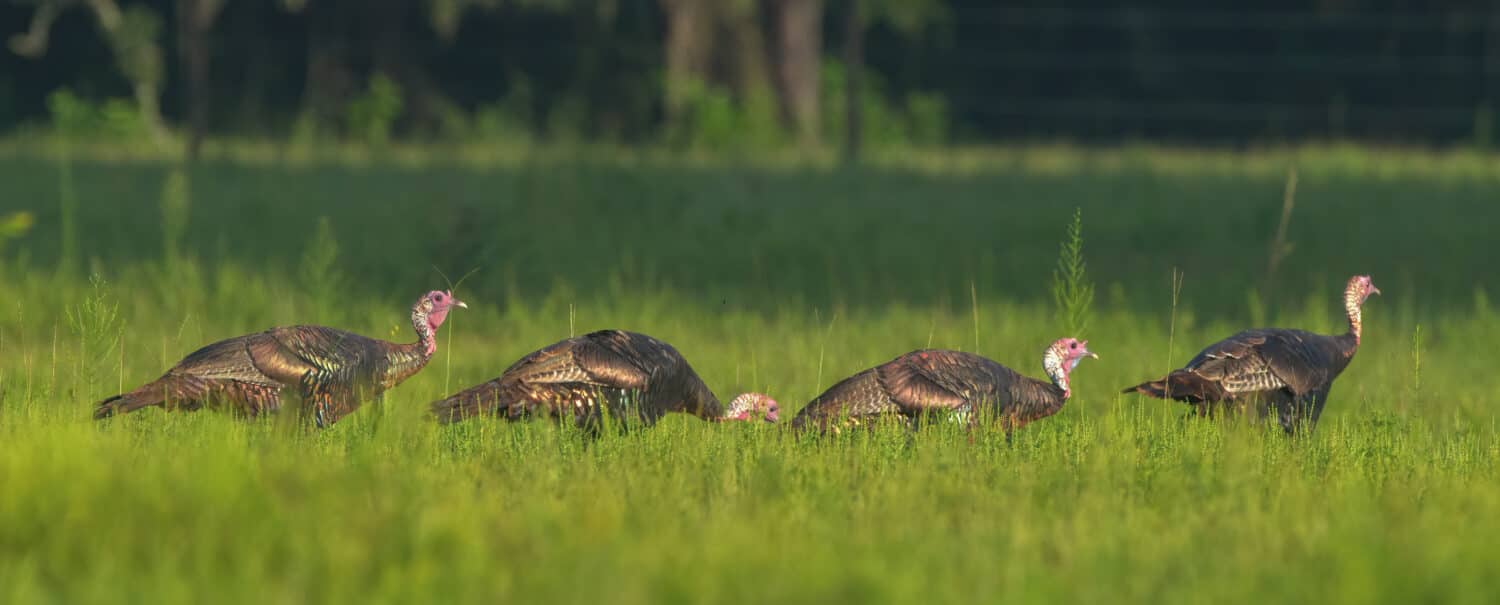Wild turkeys are a common sight along the sides of roads in the central and eastern United States. People often associate these large game birds with Thanksgiving, the pilgrims, and their distinctive vocalizations. Perhaps you’ve seen turkeys resting in trees or searching for food in a field. However, do you know where turkeys build their nests? Keep reading to learn about where turkeys nest.
Turkeys: Species Overview

Turkeys can see better than humans.
©iStock.com/Robert Winkler
The wild turkey (Meleagris gallopavo) is one of two turkey species native to North America, the other being the ocellated turkey (Meleagris ocellata). It ranks as the heaviest member of the order Galliformes, which includes other ground-feeding birds such as chickens and quail. Several subspecies of wild turkey exist throughout North America. These include:
- Eastern wild turkey
- Gould’s wild turkey
- Merriam’s wild turkey
- Osceola wild turkey or Florida wild turkey
- Rio Grande wild turkey
- South Mexican wild turkey
Mature wild turkeys possess primarily dark gray or brown feathers with a somewhat coppery sheen. Males typically feature more vibrant colors than females. Additionally, males have a characteristic red wattle along the throat and neck, as well as fleshy growths called caruncles on their reddish, featherless heads. Adult males generally measure between 11 and 24 pounds, while females measure between 5.5 and 12 pounds. They sport a wingspan between and 4 feet 9 inches long. Despite their large bodies and relatively short wings, wild turkeys can fly for short distances.
Wild turkeys are omnivores and live on a diet of nuts, seeds, berries, roots, leaves, and insects. They will also occasionally feed on small lizards or snakes. Outside of the mating season, turkeys live in sex-separated groups – males with males, and females with females. At the start of the mating season, dominant males (called toms) will form polygamous harems that can contain multiple females.
Types of Turkey Nests
Compared to some other birds, turkeys construct relatively simple nests. They do not labor for long to construct their nests, preferring only to use readily available plant material rather than searching far and wide for suitable building materials. This may be due to the fact that turkeys mate prior to constructing their nests, which limits the females’ ability to build complicated nests.
After selecting a suitable nesting sight, female turkeys scratch a shallow depression into the ground using their claws. On average, this depression measures around 1 inch deep, 9 to 13 inches long, and around 8 to 11 inches wide. Upon scratching out a depression, females will line the nest with nearby plant material, such as dead leaves.
A single clutch will contain anywhere from 4 to 17 eggs. Females lay, on average, around 1 egg per day. Laying hens often cover their nests with dead leaves and twigs when they need to leave the nest to forage or sleep. Meanwhile, incubating hens leave their eggs exposed when they need to leave the nest.
Turkey Nest Locations

Turkeys often build their nests at the base of a tree. Image: Elias Glesmann, Shutterstock
©Elias Glesmann/Shutterstock.com
Turkey nesting sites can vary wildly depending on the type of habitat. That said, most sites share a number of key similarities.
Turkeys build their nests on the ground, which puts their eggs (and their bodies) at considerable risk from predators. As a result, female turkeys seek out suitable nesting sites prior to laying their eggs. Turkeys typically choose nesting sites with close access to an opening to their breeding habitat. This might take the form of a trail, road shoulder, or simply a gap in the forest canopy.
Turkeys balance several considerations when choosing nest sites. On the one hand, the site must contain enough lateral cover to hide the nest from predators sufficiently. On the other, it must also provide the nesting female with a suitable line of sight to spot predators. Additionally, female turkeys usually choose sites with some overhead cover in the form of tree limbs, briars, or sedges.
Common locations for turkey nests include near the base of trees or low spots in dense vegetation. On some occasions, they may also make their nests in open hay fields.
When Are Turkeys Most Active?
Wild turkey activity can vary depending on the time of year, day, temperature, and general weather conditions. Understanding all of these variables contribute to the activity level of turkeys.
Wild turkeys do not hibernate, which can make surviving cold winters difficult. In more northern climates, wild turkeys often spend more time in trees during the winter. This also means they spend less time foraging. Meanwhile, turkeys that live in warmer climates are usually more active year-round. When looking at the population as a whole, turkey activity usually picks up in early spring and stays high through mid-to-late fall. Similarly, turkey activity picks up during times of mild weather. Turkeys prefer temperatures between 60 and 70 degrees Fahrenheit, which also coincides with the time when they are most vocal.
Time of day also contributes to turkey activity. Turkeys are typically most active in the early morning, just after they wake up and start looking for breakfast. They also tend to act quite active in the early afternoon before dinner. Generally speaking, turkeys prefer calm, clear days with little wind or rain. On especially windy or rainy days, turkeys are less active and vocal.
Which U.S. States Have the Most Wild Turkeys?

Missouri, Texas, and Wisconsin support some of the largest populations of wild turkeys.
©Chase D’animulls/Shutterstock.com
Experts estimate that the United States houses around 7 million wild turkeys spread throughout the country. Alaska represents the only state in the United States with no wild turkey population. Additionally, while turkeys are not native to Hawaii, a small number of introduced wild turkeys live on the island of Oahu.
Most states in the U.S. support a wild turkey population below 200,000. However, a few states support much larger wild turkey populations. These include:
- Georgia (250,000 to 300,000)
- Kansas (300,000)
- Kentucky (250,000 to 300,000)
- Michigan (200,000)
- Minnesota (225,000)
- Missouri (350,000)
- North Carolina (270,000)
- Tennessee (270,000)
- Texas (500,000)
- Wisconsin (350,000)
Based on these numbers, Missouri, Texas, and Wisconsin rank among the states with the highest estimated number of wild turkeys. Digging deeper into these numbers reveals several interesting trends.
For example, wild turkeys almost completely disappeared from Wisconsin due to overhunting in the 19th century. In the late 1970s, the state began importing wild turkeys from Missouri. This program helped the wild turkey population in the state to rebound from near collapse. On the other hand, wild turkey populations in Missouri have been on the decline for decades. In 2004, the state’s turkey population peaked at around 600,000 birds. By 2021, that number fell by nearly half to 350,000. Experts identify habitat loss, changing weather patterns, and an increasing number of predators as a few of the likely culprits behind this decline.
Which U.S. States Have the Most Domestic Turkeys?
As of 2022, around 216.5 million domestic turkeys lived on farms across the United States. That said, the vast majority of domestic turkey production occurs in just 6 states: Arkansas, Indiana, Minnesota, Missouri, North Carolina, and Virginia. Together, these 6 states raised nearly 70% of all domestic turkeys in the entire country. Of these states, Minnesota and North Carolina led the way with 40.5 million and 30 million birds, respectively.
U.S. domestic turkey production increased dramatically from the 1970s until the early 2000s. However, domestic turkey production stalled beginning around 2008. Since then, the total domestic turkey production in the country has hovered around 6 billion pounds per year. Production numbers have been on a steady, slow decline since 2017. At the same time, the price per pound of turkey meat has steadily gone up.
The photo featured at the top of this post is © iStock.com/Jens_Lambert_Photography
Thank you for reading! Have some feedback for us? Contact the AZ Animals editorial team.







